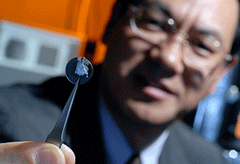Emerging Science Note/Nanogeneration
Air Date: Week of April 20, 2007

Georgia Tech Professor Zhong Lin Wang holds a sample nanowire array that can produce electrical current from mechanical energy. (Photo: Gary Meek/National Science Foundation)
Paige Doughty reports on a big development in an industry focused on the tiny.
Transcript
CURWOOD: Just ahead, colonizing the wastelands of Los Angeles. First this Note on Emerging Science from Paige Doughty.
[MUSIC: Franc Comstock “Out of This World” from Project Comstock: Music From Outer Space” (Mister Nobody – 1962]
DOUGHTY: Tiny devices that navigate the bloodstream to deliver medication have been the stuff of scientists' dreams at least since the days of the 60’s film Fantastic Voyage.
[Fantastic Voyage Excerpt Film Clip (20th Century Fox - 1966)]
But it’s not science fiction anymore. These days scientists can make devices as small as a billionth of a meter, or one nanometer, wide. But powering these "nanobots" remains a challenge.
Now researchers at the Georgia Institute of Technology may have an answer. They've demonstrated a prototype nanogenerator.

Georgia Tech Professor Zhong Lin Wang holds a sample nanowire array that can produce electrical current from mechanical energy. (Photo: Gary Meek/National Science Foundation)
Some possible applications include biosensors that use the flow of blood as power and animal monitoring devices that need no power other than the animal’s own movement.
So, while they can’t promise you a Fantastic Voyage through the human body in a miniaturized submarine just yet. The scientists do say we might be one nano-step closer to the real application of the tiny technology of the future.
That’s this week’s note on emerging science, I’m Paige Doughty.
[MUSIC: Frank Comstock “Out Of This World” from Project Comstock: Music From Outer Space” (Mister Nobody – 1962)]
Living on Earth wants to hear from you!
Living on Earth
62 Calef Highway, Suite 212
Lee, NH 03861
Telephone: 617-287-4121
E-mail: comments@loe.org
Newsletter [Click here]
Donate to Living on Earth!
Living on Earth is an independent media program and relies entirely on contributions from listeners and institutions supporting public service. Please donate now to preserve an independent environmental voice.
NewsletterLiving on Earth offers a weekly delivery of the show's rundown to your mailbox. Sign up for our newsletter today!
 Sailors For The Sea: Be the change you want to sea.
Sailors For The Sea: Be the change you want to sea.
 The Grantham Foundation for the Protection of the Environment: Committed to protecting and improving the health of the global environment.
The Grantham Foundation for the Protection of the Environment: Committed to protecting and improving the health of the global environment.
 Contribute to Living on Earth and receive, as our gift to you, an archival print of one of Mark Seth Lender's extraordinary wildlife photographs. Follow the link to see Mark's current collection of photographs.
Contribute to Living on Earth and receive, as our gift to you, an archival print of one of Mark Seth Lender's extraordinary wildlife photographs. Follow the link to see Mark's current collection of photographs.
 Buy a signed copy of Mark Seth Lender's book Smeagull the Seagull & support Living on Earth
Buy a signed copy of Mark Seth Lender's book Smeagull the Seagull & support Living on Earth

